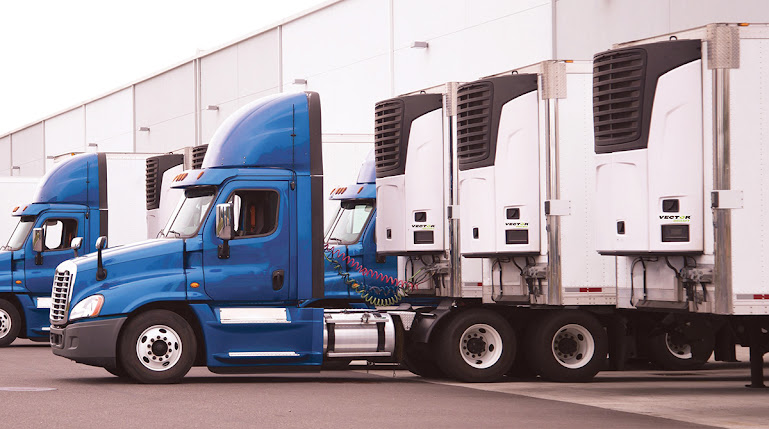Refrigerated Carriers Finding Value With Electric-Powered Reefer Units
The use of electric power to refrigerate trailers is expected to surge in the coming years, according to some manufacturers and fleet operators.
Government regulations to reduce fossil fuel emissions are a major force driving fleet adoption of electric trailer refrigeration units, also known as citrus, combined with the trucking industry’s drive to lower operating costs and reduce equipment maintenance demands.
“There is a strong movement, in general, away from fossil fuel in the transportation and logistics industry to all-electric or hybrid-electric systems,” said Ian Fox, product manager for refrigerated vans at trailer manufacturer Wabash National Corp. “Electric-powered refrigeration systems are a part of that movement. Running a reefer unit on electricity is significantly cheaper than running on diesel fuel.”
KeHE Distributors started an effort to electrify “as many distribution centers as possible about two years ago,” said Tom Harden, senior manager of fleet assets for the organic and specialty foods distributor, which has 13 distribution centers and three additional locations where it keeps trailers.
The company, headquartered in Naperville, Ill., currently operates about 150 meters. Harden said electric units are less expensive to operate than diesel-fueled units, though he pointed out that savings “vary across the country.”
Reefer
He cited an average kilowatt-per-hour cost in Stockton, Calif., of 11 to 12 cents. “But that same kilowatt-hour in Georgia is going to be around 39 cents,” Harden said.
Savings from reduced use of diesel fuel likewise differ according to local or regional variations in prices, said Harden, who added that diesel prices are higher in California than Georgia.
Gordon Food Service, which ranks No. 14 on the Transport Topics Top 100 list of the largest private carriers in North America, operates 3,200 temperature-controlled trailers. Its trailers in the U.S. are equipped with diesel-fueled TRUs “for now,” said Jason Derby, Gordon Food Service’s fleet manager for North America.
In Canada, however, the company uses diesel-electric hybrids — Carrier Vector 8600MT and 8611MT units.
Equipment & Maintenance Update cover
►Refrigerated carriers finding value with electric-powered reefer units
►The technology used to strengthen truck and trailer inspection procedures
►Technology provider hopes to strike balance on diesel engine
►Telematics strengthens communication between delivery driver and dispatch
►Baxter: Considerations for hydrogen-electric trucks
►Braswell: Adapting to the virtual environment
►Freeze: A lesson in idling
Derby likened the work of the hybrids to lighting a two-story house.
“You don’t need to light the entire house,” he said. “With an electric unit, you run only what you need, not the entire unit. The unit will give you electric heat without running the compressor. Individual fans and the electric scroll compressor can be cycled on/off as needed.”
The Road to Electrification
Wider use of eTRUs depends in some measure on increased use of electric-powered trucks, some said, as both require electrical infrastructure that, in many cases, needs to be built or upgraded.
“Certainly, there’s a very important crossover” between electrifying the Class 8 tractor market, and growing the use of plug-in TRUs and, “ultimately, the fully electrified eTRUs,” said Simon Horton, senior project manager for transportation for Southern California Edison, an electric supply company. “There’s definitely a synergy between the two electrification efforts.”
Horton noted, “We’ve got several [Freightliner] eCascadias operating in our service territory,” and several Volvo electric Class 8 tractors.
“Electric Class 8 trucks are daily doing drayage runs from the Port of Long Beach as well as intermodal runs,” he added.
Many industry suppliers expect the electrification trend to accelerate in the years ahead.
“Everyone’s moving in that direction; it’s just a matter of maturity, cost of ownership, and a lot of other obstacles,” said Paul Kroes, market insights leader at Thermo King Americas.
In the meantime, Kroes said, “There is a fairly good business case to suggest eTRUs will be pulled by combustion engine chassis, simply because there are benefits to having eTRUs regardless of what’s actually pulling them.”
Kroes estimated that “full adoption” of electric refrigeration units could be accomplished by the next decade. Mainstreaming of electric Class 8 tractors will happen first, Kroes predicted, “by 2025-2026, perhaps.”
Charging the units quickly and efficiently, wherever they are — fleet yards, distribution centers, truck stops — requires widespread infrastructure.
“The lead time to develop that infrastructure is quite long,” Kroes said, adding that bringing the cost of ownership into parity with diesel units is a goal to be reached.
As systems go more electric, diagnosing them becomes more complicated, Kroes noted.
“Technicians are usually more adept — or at least used to — diagnosing a diesel-fueled system,” he said. “Once you go to electric, the requirements for external diagnostic equipment, procedures, data downloads from the unit to figure out what’s gone wrong — that burden increases, or else it’s very difficult to figure out what needs to be fixed.”
While diagnostic software helps technicians make decisions during preventive and annual maintenance inspections, “The downside is the more sensors you attach to equipment, the higher your probability for false positives,” said Fox, of Wabash National.
The latest generation of refrigeration units has a suite of sensor and telematics packages that can help show early indication of issues, he said.
“If you notice the gallon-per-hour fuel usage on a trailer is higher or engine hours are substantially higher for a certain unit,” Fox explained, “it is worthwhile to check the reefer unit for any recent fault codes and perform a good overall inspection of the trailer structure to ensure everything is in good working order.”
Advances in microprocessor-based controllers are making systems more efficient and reliable, as well as enhancing diagnostics for maintenance, said Bill Maddox, a senior product manager at Carrier Transicold.
Operating software in controllers, such as Carrier Transicold’s APX control system, records data about system operations. Maddox noted that it can speed up the process of diagnosing problems and can often lead a technician directly to the point of trouble.
He said telematics systems in the refrigeration units are designed to further enhance maintenance and monitoring. Carrier Transicold’s eSolutions telematics system “can give fleets a bird’s-eye view of all of their refrigerated assets,” monitoring temperatures, location and overall TRU performance. Centralized monitoring via telematics can help build a comprehensive record of individual TRUs in a fleet by tracking factors such as engine run hours and other data collected by the TRU controller, Maddox added.




Comments
Post a Comment